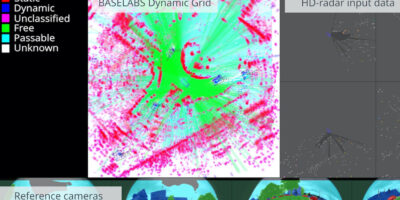Algorithm models raw sensor data for urban driving
High resolution, raw sensor data can be used by an algorithm created by BaseLabs, to generate a consistent environment model for future urban driving functions.
Dynamic Grid accelerates the development of data fusion systems for automated driving functions, particularly in urban environments. It means automotive developers do not have to undergo time-consuming algorithm training but can develop driver assistance systems such as parking functions or traffic jam pilots with better performance than traditional tracking and grid methods, says the company.
Automated driving functions for urban areas are demanding for environment modelling. Using high resolution sensors to acquire the required data with a sufficient level of detail is thwarted because traditional algorithmic methods of sensor fusion are limited. Dynamic Grid can process the high resolution sensor data (from radars or laser scanners, for example) at the raw data level.
It is also possible to use cameras with semantic segmentation. As a result, Dynamic Grid provides a self-consistent environment model that detects dynamic and static objects in the vehicle environment. It also estimates free space to identify drivable areas or parking spaces. The algorithm runs on automotive CPUs in real time and is implemented according to ISO26262
Dynamic Grid is suitable for driving functions for automation level 2 and above, including highly automated driving. Typical application areas are automated parking functions, for example valet parking, emergency braking functions with automatic avoidance, or traffic jam pilots. The algorithm is also suitable for use in radar subsystems.
Dynamic Grid is a superior alternative to using traditional tracking methods and a static occupancy grid, explains Norman Mattern, head of product development at BaseLabs. “By processing the data in an integrated manner in a self-contained algorithm, we avoid inconsistencies that the combination of two different methods in the traditional approach often entails. Dynamic Grid can show its strengths especially in scenarios with many objects and different directions of motion in the vehicle’s environment,” he said. The algorithm can detect and track objects of any shape without extensive training, he added.
BaseLabs provides software to make the development of sensor fusion efficient and scalable. It is a partner for automotive manufacturers and suppliers worldwide.
The company was founded in 2012.




